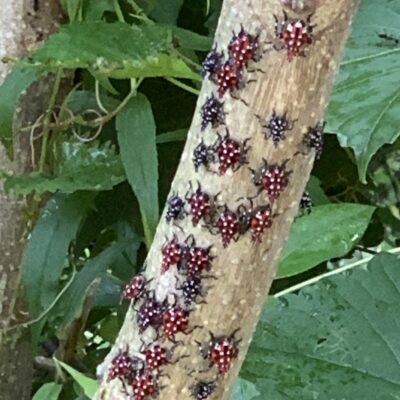What is Spotted Lanternfly?

Spotted lanternfly could be mistaken for a beautiful and delicate moth. The bright red accent on the wings and the cute polka dots make it look harmless. Quite the opposite is the case. These tiny insects are destructive and potentially harmful to the US orchard, grape, and logging industries.
These critters have been in the US since 2014, but now, they have crept into Northern Virginia. With the recent sighting in Loudoun County in August 2022, we need to be diligent to cease the spread.
See how to recognize them and what to do if you find one (or more) in your area.
What is a Spotted Lanternfly?
The spotted lanternfly is a pest native to China and was first discovered in Pennsylvania in 2014. They have four recognizable life stages, with the adults being the most colorful and easiest to identify.
Lanternflies have several host plants that they feed on. Their favorite is the Tree of Heaven. This plant is native to China as well and is considered an invasive species in the US.
Spotted lanternflies don’t fly very far. They are transported by unknowing visitors to new areas. Female insects lay eggs on a multitude of smooth surfaces. No firewood, brick, vehicle, camp accessory, or outdoor furnishing is considered off limits for egg laying. Egg masses are easy to overlook since they resemble smears of mud or clay.
Luckily, they do have a few native predators, but so far, that has not been enough to control the populations. So it is important that we stay vigilant and report sightings.


Why Spotted Lanternflies are Harmful?
Lanternflies are a form of sucking insects. That means they pierce the stems and branches of their host plant and suck out the sap. This causes damage to the bark and leaves an opening for other pests to enter the plant. Spotted lanternflies will also suck sap from the leaves and then excrete honeydew. Honeydew is a sticky substance that attracts other insects that can cause even more damage.
What to do if you see Spotted Lanternfly?
The USDA as well as individual states have been tracking spotted lanternfly populations and movement since they were first spotted in 2014.
The general public plays a significant role in stopping the spread of this harmful insect. Cornell University maintains a quarantine map to show locations of spotted lanternfly populations. The living stages of this pest cannot be moved into or out of quarantine areas. Therefore, inspect your vehicles and belongings for signs of the insect before leaving a quarantined area. If you find spotted lanternflies, destroy them to avoid moving them to a new location.
If you’re out and about your hometown and see signs of these insects, photograph the insect, report the location, and destroy small populations manually.
We’ve listed links to the local extension service websites where Spotted Lanternfly is known to be. Instructions on how to report their location are listed on each page. If you see spotted lanternflies in an area not listed below, search for the state’s extension service website and contact them directly.
Have you seen something that looks strange on your property? Think it could be a spotted lanternfly or maybe another landscape pest. Our Green Peace of Mind experts are here to help. Give us a call and we can schedule an on-site evaluation.









